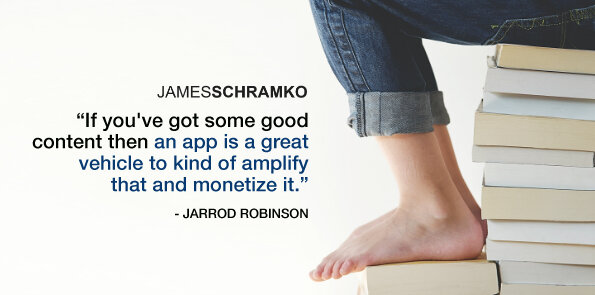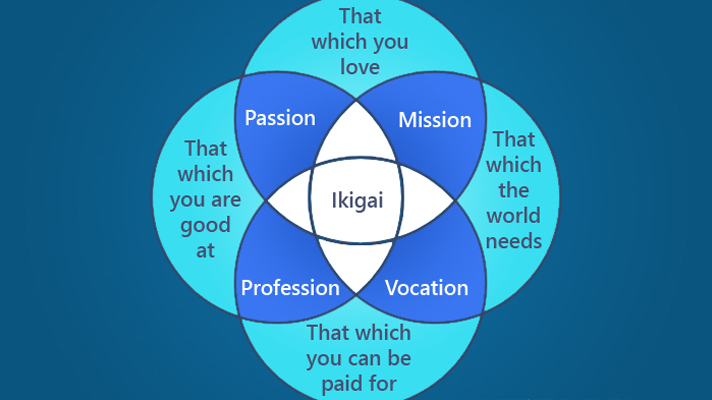Podcast: Download (Duration: 37:28 — 35.1MB)
Get Notified Of Future Episodes Apple Podcasts | Spotify | Amazon Music | Android | Blubrry | Gaana | TuneIn | Deezer | Anghami | RSS | More
As app builders for hire, Jarrod Robinson and his team at TheAPPMatch create app solutions for clients that can serve as lead magnets, add value to their product offerings, or be sold as standalone products.
In the past two years, one of the things they’ve been doing a lot of is turning existing, “stale” content into apps. And in this podcast episode, Jarrod will answer questions business owners may have around this.
Is it easy to make an app?
How to create an app for my business?
What is the process to get an app from a provider like Jarrod?
James and Jarrod will go into these topics as well as the real benefits to be had from having a content-based app.
Table of contents
1. App creation is easier than ever
2. New products from old material
3. James’s experience with repurposing content
4. When you’ve built a following…
5. A recurring benefit at low price points
6. Too easy to be real?
7. How The App Match gets it done
8. The volume that makes an app viable
9. A scenario to look at
10. Other use cases to consider…
11. At such low ticket, what’s the payoff?
12. With so much going for apps…
13. A credible expert to consult
App creation is easier than ever
Creating apps has become significantly more accessible, thanks to advancements in AI and code generation. Basically, if you can communicate what you need, you can get an app developed.
While knowing what to code is still necessary, platforms like theappmatch.com simplify the process for users, letting them create apps without extensive coding knowledge.
App creation has accordingly become less costly. While it’s still possible to spend large sums on app development, says Jarrod, most people don’t need to.
New products from old material
Jarrod’s business has traditionally been helping people build app solutions for existing products like memberships. In the last couple of years, however, people have come to them about using old, “stale” content to create apps.
This approach involves taking existing material like eBooks and repurposing it into simple, effective applications that offer users a straightforward journey from point A to point B. This method has proven successful for many, as it taps into the value of previously created but underutilized content.
James’s experience with repurposing content
James reflects on his own experience with content repurposing. He’s recently switched away from an older system where he had a wealth of products, some of which had been active for over a decade.
James stresses the value of not just creating new content but also revisiting and reusing older materials. He has in fact begun converting his old products into YouTube videos, thereby creating new, engaging content that leads viewers to his paid products.
The Pareto Principle, or the 80:20 rule has been a guiding principle for James. For about seven years, he consistently created new training every month, and turning the most popular topics into more polished products.
For instance, James’s successful “How to Double Your Income and Halve Your Work Hours” presentation evolved into the foundation of his book, “Work Less, Make More“. James recommends looking at past content to identify what resonated most with one’s audience, using popularity as a metric for repurposing potential.
James acknowledges that not all content achieves the same level of success. Some of his creations didn’t resonate as broadly. So instead of relying on a single product for success, he suggests continually producing content, observing audience responses, and then enhancing those that show promise.
Jarrod expands on this, suggesting that apps can serve as an effective way to repurpose content. In James’s case, he could leverage his YouTube content to lead viewers to paid products, with the app acting as a free product that guides users towards more comprehensive offerings. This approach positions the app as a lead magnet, offering free value while directing users to premium content.
When you’ve built a following…
Successful social media influencers, says Jarrod, often monetize a large social media following by creating subscription-based offerings, which can accumulate over time like a snowball effect.
James explains that many influencers use lead magnets to transition their followers to paid offers, such as books, courses, or other resources. In his case, he initially offers a free book to attract his audience, followed by a paid, recurring service.
James is considering raising the price of his service to match the value he delivers and the clientele he prefers working with. Additionally, he collaborates with partners like Jarrod to offer complementary services, like app development. James highlights a successful business model that bridges free content and high-ticket programs, with smaller recurring apps serving as a viable intermediary step that repackages existing content for monetization.
A recurring benefit at low price points
Curating existing content into apps can generate a stable, recurring income. Converting free blog content into a more structured and user-friendly app experience, says Jarrod, allows creators to charge an ongoing fee, even at lower price points, compared to the irregular sales patterns typical of eBook promotions.
James points at the appeal of monetizing content through low-cost subscriptions, especially in a market where consumers might be wary of expensive courses. He himself is subscribed to various low-ticket apps like Oura and MyFitnessPal.
Jarrod and James touch too on the ease and convenience of Apple’s billing infrastructure. This system not only simplifies purchases for the user but also handles failed payments, contributing to a smooth customer experience.
Too easy to be real?
James questions the simplicity, though, of creating subscription-based apps from existing content, suggesting that it seems almost too good to be true. What are the potential complexities?
While the process might appear straightforward, says Jarrod, it often involves distilling grandiose ideas into more manageable, bare-bones products. This approach involves focusing on creating simplified versions of content that can deliver results and generate ongoing revenue.
How The App Match gets it done
To turn content into an app, clients provide their material (like PDFs, Excel files, or RSS feeds) to The App Match, which handles the technical conversion into app format.
This process allows clients to focus on promoting their upcoming app, while The App Match simplifies and manages the technical aspects, ensuring that the content is effectively transformed and ready for app deployment.
The App Match takes care of all aspects of app creation, including design elements like icons, screenshots, and marketing imagery. They leverage their experience from building hundreds of apps to optimize the presentation and functionality for different niches.
The service offers flexibility in payment, with both monthly and yearly options. The focus is on enabling clients to amplify and monetize their content through apps without worrying about technicalities or platform requirements.
The App Match’s services are designed to be accessible, even to those without technical expertise. With guidance and support from The App Match, clients can also actively participate in building their apps. This accessibility underscores the practicality of using apps as a medium to amplify and monetize quality content, making it an attractive option for content creators looking to expand their reach and revenue streams.
The volume that makes an app viable
The feasibility of developing an app for a business largely depends on the size of its audience. For those with a smaller clientele, such as a few individuals paying high rates, leveraging existing tools might be more practical than creating an app.
For businesses with a larger audience, numbering in the hundreds or thousands, developing an app could be highly beneficial. This is especially true for those seeking to provide value to a large number of people at a low price point.
For those with audiences in the millions, an app presents a significant opportunity, a “home run”, says Jarrod, in terms of potential success and reach.
A scenario to look at
James provides a scenario around a friend of his. A personal trainer focusing on executive fat loss has a significant social media presence, particularly on LinkedIn, and uses a white-labeled fitness app to interact with his clients. This trainer is considering whether to create his own app to bridge the gap between social media engagement and client acquisition.
It makes sense, says Jarrod. The app could either serve as a lead generation tool or evolve into a primary product if it gains enough traction.
While the trainer’s information is thorough and proven, says James, the real value lies in the personalized guidance and accountability he provides, suggesting that the app could offer basic information for free or as a paid service, with an upgrade option for personalized coaching and monitoring.
Other use cases to consider…
Jarrod highlights a variety of unique applications for subscription-based apps, showcasing their versatility across different niches.
One standout example is an app providing weekly horse racing tips and insights, monetized through a recurring weekly subscription. This app does not involve gambling directly but offers valuable information for those interested in horse race betting.
Another example comes from Jarrod’s own niche of physical education, where they offer a downscaled version of their main membership as an app. Priced at only $2 per month, this app contains selected content from the larger membership and caters to those in their audience who might not afford or need the full membership. This demonstrates a successful implementation of an app as a downsell strategy.
At such low ticket, what’s the payoff?
James is initially skeptical about the significance of a $2 monthly subscription, wondering if it can contribute substantially to one’s income.
Jarrod says that such low-priced, recurring subscription products have been fundamental to his business success. These models, particularly in large markets like sports education for children, can accumulate to form a significant income.
Jarrod further explains that both B2C and B2B models can thrive with this approach. He cites an example of a small business or hobby project generating a couple of thousand dollars monthly through such subscriptions. James acknowledges that amount can potentially cover expenses like rent or car payments.
Because this approach leverages existing content, it can create an additional, steady revenue stream without significant extra work.
James reflects on the effectiveness of the recurring subscription model, considering it a key lesson in online business. The model’s predictability and reliability is something he has benefited from since 2009.
James appreciates Jarrod’s method as an intermediary step, an easy way to let existing resources generate a steady, recurring income, and enhance the business model he’s already experienced success with.
With so much going for apps…
With current technology, creating an app is neither too hard nor too expensive, and there’s ample guidance available for the process. Plus, the recurring income it can create is definitely attractive. So what if you don’t have existing content?
Jarrod suggests that creating specific content for a targeted goal is viable and can be assessed through services like theappmatch.com. He advises, too, turning the app into a standalone product, which provides a clear measure of its value through direct sales metrics.
Jarrod is more for treating an app as a product rather than just a lead generation tool. This approach provides a straightforward metric for success: sales are either made or not, removing ambiguity about the app’s value to the business. It helps to quickly determine the app’s practical worth and its impact on the business, thereby guiding investment and development decisions.
A credible expert to consult
James expresses appreciation for Jarrod’s honesty and straightforwardness, especially when advising clients on whether their app ideas are viable. He notes too that Jarrod, being a trained educator, has a keen eye for content structure and organization, which is crucial in creating effective apps.
Jarrod acknowledges his inherent critical nature, which he uses to ensure that any app development he undertakes will genuinely benefit the client and be not only effective but also profitable.
Jarrod believes strongly in the power of recurring subscriptions as a business model, citing his own success in turning an app into a high-value asset, due to its recurring nature.
James heartily endorses Jarrod’s expertise, and encourages listeners to seek experts like Jarrod for app development.
If you’d like to match your existing content to an app product opportunity, connect with Jarrod at theappmatch.com/match.
Liked the show? Enjoy all the episodes when you subscribe on iTunes












Leave a Reply